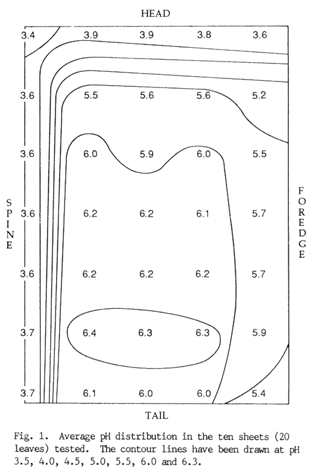

When Nick Hindhaugh (now at the V & A Museum) was a student at the Camberwell School of Art & Crafts, he did an in-depth study and conservation rebinding of a book printed in Venice in 1508 on good rag paper, but now suffering significant paper loss due to embrittlement. His study involved surveying the pH of 10 representative two-leaf sheets at 63 locations on each sheet. He reports the result of this survey in v.14 of the Paper Conservator (1), from which the map below is reproduced, with the permission of the publisher and author.
What strikes one immediately is the wide range of pH within the sheet: 3.4-6.4. (A difference of only one pH point between the edge and the middle of the average page has been commonly assumed. Perhaps this assumption is correct, and the 1508 book is very unusual; but we don't know, because there have been too few pH studies to provide a good database.) Hindhaugh tentatively explains the distribution of high and low pH as a result of binding materials on the spine, and exposure to air. The book had been rebound three times, most recently in alum tawed skin with a pH of 3.0. The paper's low pH at the spine fold is attributed to the migration of acid from the binding through the paper over the years. The high pH at the tail and the middle of the pages appears to be due principally to the exclusion of air and distance from the spine. The penetration of acid from the edges is deeper where the pages are less tightly held together, i.e. at the foredge.
This study is relevant to several aspects of preservation, but particularly to ongoing studies of the effect of gaseous pollutants on deacidified books, and in fact the author cites me earlier study on SO2 uptake. The effect of temperature and relative humidity over the last 480 years, by the way, could not have been nearly as important as pollution in the deterioration of the book paper, because they would have affected all parts of the book equally.
Washing brought the pH of the book pages up to the 6.57.1 range.

Fig. 1. Average pH distribution in the ten sheets (20 leaves) tested. The contour lines have been dream at pH 3.5, 4.0, 4.5, 5.0, 5.5, 6.0 and 6.3.
1. Nick Hindhaugh, "A pH Survey of an Acidic Textblock." Paper Conservator v.14, 1990, p. 17-22. Copies of this volume are available from the Institute of Paper Chemistry (Leigh Lodge, Leigh, Worcester WR6 5LB) for £15.00 ($30), which includes surface postage. Add £5 ($10) for airmail. All back volumes are available for $15/volune, with a discount for members of IPC, and a list of contents, v.1-13, is available.